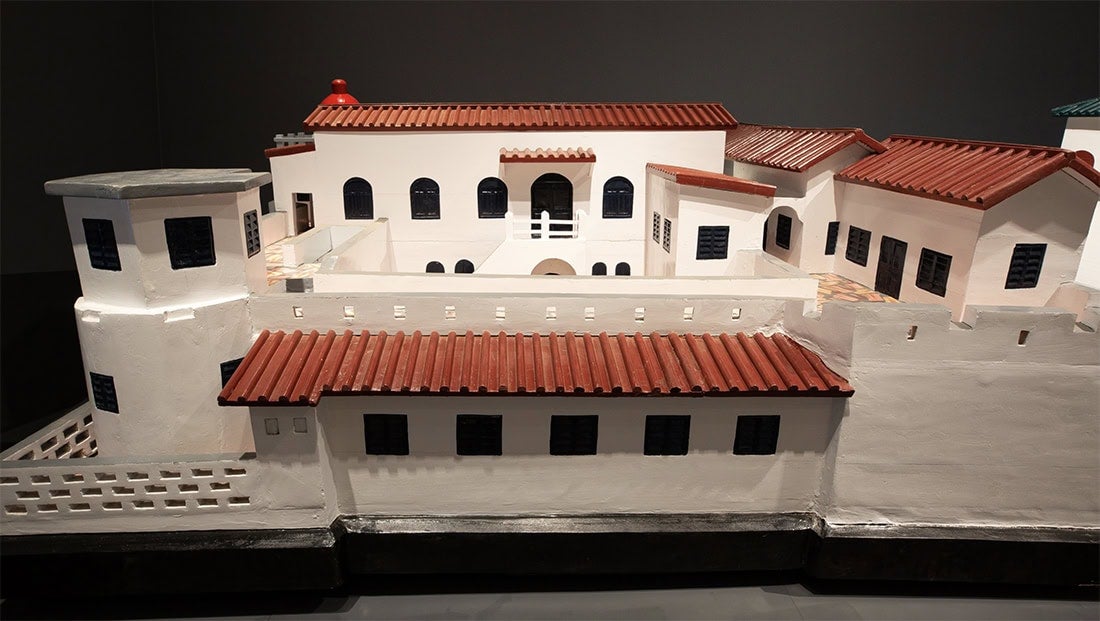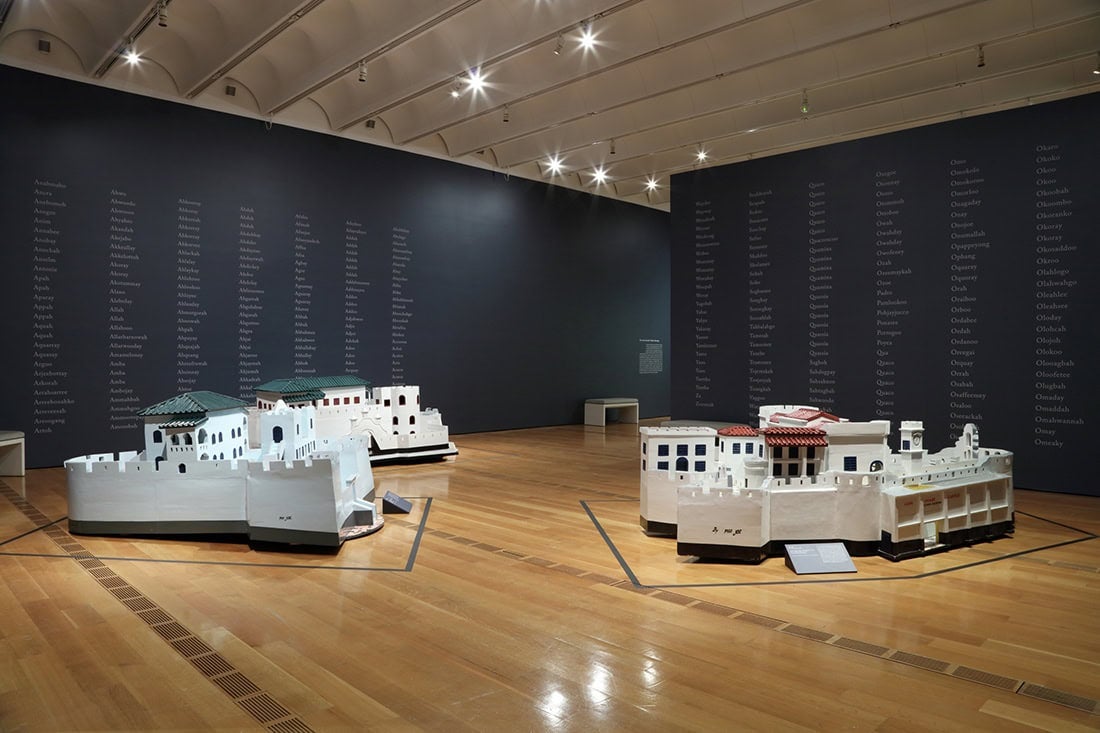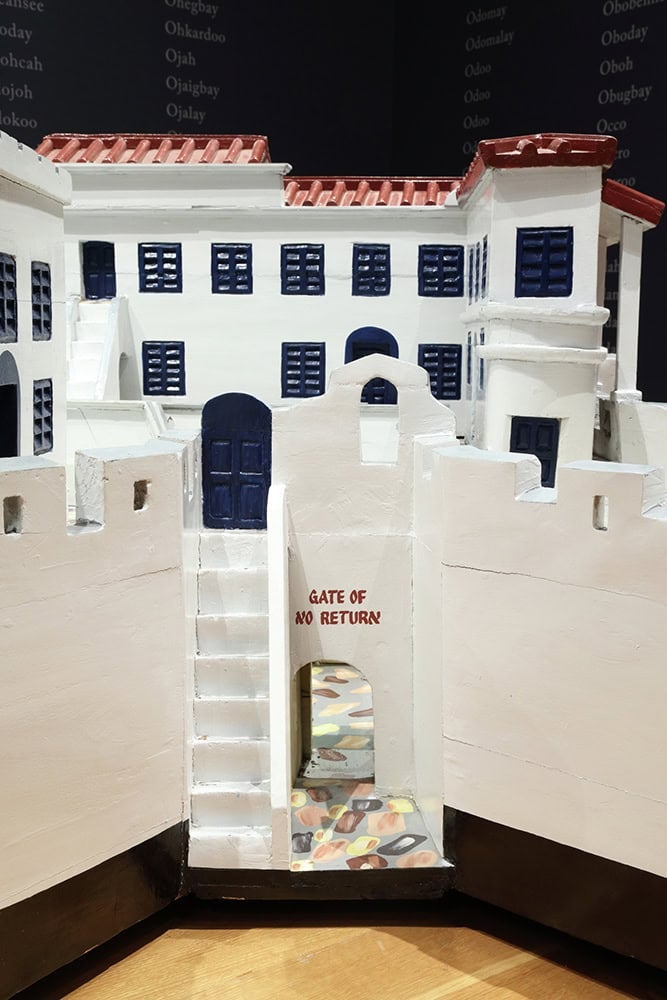
Paa Joe, Fort Orange – Sekondi. 1670’s Netherlands, 1872 Britain, 2004–2005 and 2017; emele wood and enamel. Courtesy of the artist and Jack Shainman Gallery, New York. Photo by Olya Vysotskaya, courtesy American Folk Art Museum, New York.
I had big plans for writing about Paa Joe. In early March—which now seems like a world away—I went to see Paa Joe’s solo exhibition Gates of No Return at Atlanta’s High Museum of Art. The following morning I boarded a plane to Los Angeles, where, coincidentally, the artist had just opened another smaller show in the zine shop of the excellent gallery The Pit, out in Glendale. Perfect: compare and contrast.
Paa Joe creates dazzling otherworldly constructions, big wooden spaceships shaped alternately as a regal lion, a luxury vehicle, a Coca-Cola bottle, a Sony Walkman. They are unclassifiable as artworks, deeply carnivalesque, almost cartoony looks at everyday life. Then the top flips up, revealing the double lives of these works as fully functional coffins. In Ghana these artworks are called abeduu adekai, or “proverb boxes,” and belong to a tradition of honoring and ushering the dead into the afterlife with all of the pomp of a flamboyant departure. Distinctive and highly customized, the coffins symbolically depict the lives of the deceased: their hopes, passions, and aspirations.
In death, every Ghanaian is a king: it takes time to organize a befitting burial. Some funerals happen many months after the end of someone’s life, some take years. The family has to designate a “chief mourner.” The dearly departed’s home has to be renovated to be a suitable stage for the procession. A glossy funeral brochure, with design, production, and tributes must be compiled. Flight arrangements for relatives around the world must be negotiated. And, of course, the handcrafted and hand-painted coffin must be procured. On the day of the funeral, a large crowd of mourners congregate, many whom may have never met the deceased. The last rites are a societal event. It is often said the life of a recently deceased Ghanaian is worth more than that of one still walking with us.

The world seemed relatively normal as I boarded the plane on the morning of March 11. As we took off, so did COVID-19. Upon landing in LA and turning off airplane mode on our phones, the faces of my fellow passengers dropped. News alerts were dire. We feared we might lose Tom Hanks. In a rental car, I went to two different Whole Foods and found aisle after aisle of empty shelves. The trip to see Joe’s work the next day at the Pit was now off, everything was canceled.
I wanted to get back into the High Museum before writing this to refresh myself, but I couldn’t. They reopened in early July, taking precautions for the health and safety of their visitors (timed tickets and hand-sanitizing stations). As our state continues to hit daily highs in cases, a day in the museum does not feel essential. For the past twenty years, not a single week has gone by where I haven’t visited a museum. It’s a fundamental part of who I am, and yet for the past four months—and going forward—I’m too scared to go into a building to experience art with others.

Paa Joe, Cape Coast Castle. 1653 Sweden, 1665 Britain (detail), 2004–2005 and 2017; emele wood and enamel. Images by Mike Jensen, courtesy High Museum of Art, Atlanta.
But all is not lost. I have never seen the High do such an excellent job making their exhibitions accessible via the website. There are numerous images, a narrated exhibition tour led by curator Katherine Jentleson, and several links that provide local context about Atlanta’s role in the slave trade (see the Five Points MARTA station auction blocks and “Slave Square” in Oakland Cemetery). For a more global view, a linked video shows the sheer scale of the devastation of the enslavement of Africans by European nations. In the time-lapse video, there is no time to blink. 31,164 slave ships. Six million Africans enslaved and sent to the Americas and the Caribbean from Gold Coast fortresses in Ghana, the Bight of Benin, Bight of Bonny off the coasts of Nigeria and Cameroon. From Sierra Leone to the coast of Madagascar. 31,164 dots. Untold wealth for Portugal, Great Britain, France, Spain, the Netherlands, the United States, Denmark. It makes your head hurt and brings tears to your eyes.
The sculptures in Gates of No Return are not Paa Joe’s most fan-friendly, but they are his most important. Initially commissioned in 2004 by Claude Simard, Joe created eleven coffins (seven of the original eleven are at the High) representing the fifteenth-century castles that served as weigh stations for slave ships heading to the new world: Christiansborg Castle, Fort Patience, Cape Coast Castle, Fort St. Sebastian, Fort Orange, Fort Gross-Friedrichsburg, and Fort St. Anthony. As President Obama phrased it during his 2009 visit to the Cape Coast, these sites are the “very start of the African American experience.” Even as sculptures prompting us to remember, to remind, to educate, the fortresses are still chilling. These works depict sacred sites, jarring remnants of our brutal past and portents of our brutal present. They aren’t comfortable to sit with. Thick, whitewashed wooden walls, they were the vessels before the vessel, a forever view of racial history. Everything since is the afterlife.
Paa Joe: Gates of No Return is on view at the High Museum of Art in Atlanta through August 16.




